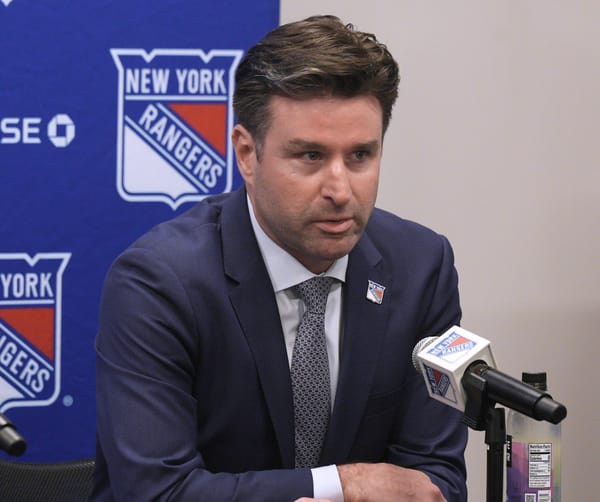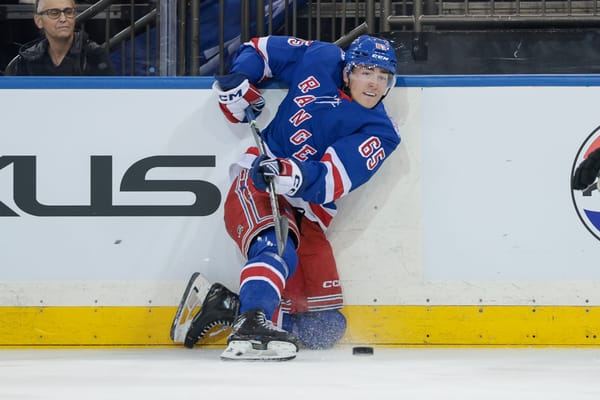Should the Rangers Trade J.T. Miller or Chris Kreider? Or Both?
On February 8, the New York Rangers made a bold move in placing Brendan Smith – who re-signed with the Blueshirts after a brief post-deadline stint on Broadway to the tune of $17.4 million dollars over 4 years – on waivers. The team followed it up with a press conference and an official statement more or less declaring a rebuild without quite saying as much. The implications were clear: everyone was on the table as we approach the deadline and gear up for next season, with the end goal of bringing a Stanley Cup back to the Big Apple following years of contention with ultimately nothing to show for it.
“As we approach the trade deadline later this month and into the summer, we will be focused on adding young, competitive players that combine speed, skill and character. This may mean we lose some familiar faces, guys we all care about and respect. While this is part of the game, it’s never easy. Our promise to you is that our plans will be guided by our singular commitment: ensuring we are building the foundation for our next Stanley Cup contender.”
The obvious names were thrown around first, with the immediate attention going to highly-touted rental forwards Rick Nash and Michael Grabner, in addition to two of the Rangers’ mainstays in Ryan McDonagh and Mats Zuccarello. A couple of notable names that have gotten lost in the shuffle however, especially as smoke builds around a possible Nash or McDonagh trade, were J.T. Miller and Chris Kreider, both of whom were mentioned by Darren Dreger on TSN’s Insider Trading as having generated some interest.
As the team looks toward the future, hoping to generate assets and clear cap space while retaining some foundational elements to build around, would it be worth it for the Rangers to listen to calls on either or both of the young power forwards?
The two wingers play a similar style and are right in the thick of their prime years as forwards, Miller being two years younger than the 26-year-old Kreider. They both form crucial components of the Rangers’ offense, with Miller putting up a stat line of 22-34-56 to Kreider’s 28-25-53 in the 2016-17 regular season, and, using points per 60 minutes to account for the difference in point totals due to Kreider’s midseason injury, are relatively comparable in 2017-18 given Miller’s 1.68 p/60 and Kreider’s 1.72. There is one major difference between the two though: contract status.
Kreider – having come off his entry-level contract at the end of the 2013-14 season – moved onto a bridge deal for two seasons and entered into his current $4.625m deal in 2016-17, and he’s set to hit UFA status in 2020-21. Miller on the other hand wrapped up his ELC in the 2014-15 season, signed a one-year contract for 2015-16, and then found himself on yet another bridge deal set to expire at the end of this season, at which point he’ll become a restricted free agent one year away contractually from unrestricted free agent. How the Rangers manage these two players as assets may prove crucial to the team’s rebuild, as Rangers GM Jeff Gorton will certainly want to capitalize on the trade market for young scoring wingers while managing his salary cap effectively through the coming years on the road back to true Cup contention.
The question here is whether the Rangers should keep both Miller and Kreider, trade one of them, or trade both of them. On a basic level, if a GM has two players who seemingly fill similar roles, put up similar point totals, and are close in age but worlds apart in terms of their contract status it makes sense that they would want to trade one. Why have two of the same thing when you can keep one and fill an organizational need by trading the other? Especially when there’s a rebuild on the horizon, a good GM with a long-term game plan will want to think long and hard about which player they prefer, both in terms of on-ice performance and the effect they’ll have on the team’s cap management. Hopefully Jeff Gorton does his homework however, because the two players are not as alike as they might seem.
While on the surface the two seem pretty evenly matched in terms of point production, digging a little bit deeper yields different results. This current season, in the games he’s played, Kreider ranks fourth out of Rangers forwards in terms of raw CF% at 48.94 (the Rangers have not been a strong possession team this year, if you can imagine that), with a relative CF% of 3.36, good for third among Ranger forwards. Miller on the other hand is 7th in that same peer group as far as raw CF% goes at 45.84% and 7th for rel CF% at an unremarkable -0.74%.
Of course, generating shots is great and all, but when two players seem to put the biscuit in the basket at the same rate, it’s worth asking who comes closest more frequently. When considering expected goals for, Kreider drops a few spots to 5th among Rangers forwards for xGF% at 51.22 and 6th in rel xGF% at 2.97. Miller remains just a few spots lower at 9th in xGF%, a 47.64% ratio, and 8th in rel xGF% at -0.65. Although their rankings in these stats are not so disparate, the actual numbers are decently far apart, making Kreider seem like the better of the two players.
The numbers look even worse for Miller when analyzing last season’s stats; he posted a 44.99 CF%, a -4.00 rel CF%, a 46.07 xGF%, and a -3.93 rel xGF%, hovering around the mid-teens in terms of forward rankings. Kreider outshines by a wide margin in this framing as well, where his numbers were 53.75%, 7.81%, 54.30% and 8.33% in those same respective categories (for these stats Kreider is near or at the top of the list for Rangers forwards, including outliers who skew things a bit like Marek Hrivik, who played less than 200 minutes).
Before we go and write off Miller completely, it’s important to remember that one of the things he excels at more distinctly than Kreider is playmaking ability. In order to draw a fair comparison here, it’s useful to look at Corey Sznajder’s work tracking zone entries, exits, and passing plays, which has been visualized by CJ Turtoro. Miller’s utility comes into sharper relief when examining the Rangers’ past two seasons through this lens, and it should not be discounted. The charts below are visualizations of data representing zone entries, exits, and passing plays from this current season, followed by a comparison of the two players’ 2016-17 and 2017-18 seasons. For all of this data it’s an important caveat to note that Sznajder hasn’t tracked quite the same amount of games for either the data from this season or the past season, but the exact TOI tracked for each player is close enough that we can make a solid comparison.
For the 2017-18 data we’ll look at first, Corey tracked 378 minutes played by Miller (28 games played) to Kreider’s 306 minutes (24 games played).
Here, looking at strictly types of zone entries per 60 minutes, it’s hard to say if Miller or Kreider is better or worse – they’re mostly just different. Miller is clearly the better playmaker, with 6.187 entry passes per 60 minutes to Kreider’s 3.534, although Kreider both skates it and dumps it in at a higher rate than Miller, 4.515 carry-ins per 60 and 9.620 dump-ins per 60 compared to 3.807 carry-ins per 60 and 7.138 dump-ins per 60, for the two players respectively.
Again, with regard to exits, we see the differences in Miller and Kreider’s playing styles. Miller is plainly the better passer here too, making 6.345 exit passes per 60 minutes compared to Kreider’s 4.515. Kreider edges out Miller just barely: 4.319 to 4.283 as far as carry outs per 60 minutes is concerned, but overall Miller exits the zone with possession more times per 60 minutes than Kreider. Kreider has Miller beat when it comes to the more dubious distinctions of dump-outs and clears per 60 minutes, with his numbers there being 2.160 and 7.657 respectively to Miller’s 1.110 and 3.648 in those same categories. So, while Kreider may get the puck out more than Miller overall, Miller will help you get the puck out of the zone with possession more frequently than Kreider.
Analyzing shots and shot assists again lends credence to the idea that the two young, hard-hitting forwards might not be so similar after all, with each player’s MO being borne out pretty distinctively by the data. Kreider is simply a monster at generating shots, producing 12.56 per 60 minutes while Miller only puts up 7.77. Miller meanwhile makes the passing play more often than Kreider, with the former’s primary and secondary shot assist rates of 11.26 and 5.23 both being higher than the latter’s 8.64 and 3.73 (interestingly enough Kreider just slightly wins out over Miller in terms of tertiary shot assists, 0.79 to 0.63).
Lastly, as far as charts go, we’ve got the two players’ head-to-head comparisons, for both last season (1061 minutes/74 games tracked for Kreider, 1110 minutes/81 games tracked for Miller) and this season (306 minutes/24 games tracked for Kreider, 378 minutes/28 games tracked for Miller). Looking at last season’s matchup between the two, we see that Miller is in a higher league-wide percentile than Kreider in everything except shot contribution/60 (which takes into account Miller’s low shots/60 rate), shots/60, and percentage of zone exits with possession, while Kreider still ranks highly in all of them, demonstrating perhaps a more well-rounded game.
Things shift a bit when you look at where both Kreider and Miller are right now, in the 2017-18 season. Looking at the present, Miller still lags behind in shot contribution/60 and shots/60 (although he’s improved slightly) while totally outpacing his teammate in shot assists/60. Miller does however have Kreider beat in every zone entry/exit category left on the chart, cementing himself in the upper echelons across the league as far as moving the puck from end to end goes, all while Kreider looks downright pedestrian.
So after all of this digging through data we’re left with this: both Chris Kreider and J.T. Miller can produce a solid 55-ish points a season, good enough for a top-six position on the depth chart. Although Kreider has the better underlying numbers as far as shot generation and expected goals go, looking at zone entries/exits, shots, and shot assists, it becomes apparent that Kreider is the more traditional north/south power forward while Miller, though he plays a hard-nosed game, is a bit more of a playmaker. All of this is fine and good but again, their contract situations are markedly different and the Rangers are preparing to enter into a rebuild. How does it all come together?
It’s relatively easy to project Miller’s next contract, given the straightforward comparison that can be drawn between Miller and his Rangers teammate, Mika Zibanejad. Zibanejad came off a $2.625m AAV bridge deal that lasted two years, signed following his entry level contract, and renewed with the Rangers last summer for $5.350m each season from 2017-18 until 2021-22. Zibanejad and Miller are similar playmakers, put up similar point totals (Zibanejad was on pace for 58 points last year but lost time to injury, while Miller had 56), and were both born in the spring of 1993. It’s not unreasonable to think then that the Rangers would hope to get Miller on a similar contract if they do intend to keep him, although it is also important to recognize that Miller is a year closer to UFA status than Zibanejad was at the time he re-signed, so Miller may wind up in the $5.5-6m range rather than the $5-5.5m range. A contract like Zibanejad’s would last the entirety of the Rangers’ rebuild and see him through to what the Blueshirts hope is a return to contention, but with the team mindful of the new young players they’ll also be giving contracts to down the line, they may not want that fixed element on their payroll.
Finding a good parallel for Kreider is a bit trickier, but with him it’s less about the dollars and cents and more about whether the Rangers will see him as a worthwhile, veteran member of their leadership group by the time they’re done retooling their roster. With a deal set to expire at the end of the 2019-2020 season, likely around the time Jeff Gorton is hoping to be moving back towards Cup contention, management will want to have already decided on his future with the Rangers. That means that even if we don’t see Kreider moving on this trade deadline he may be departing from New York sometime after that, depending on when the Rangers get a better sense of how their new core of players is going to look. Another wrinkle in the Kreider situation is his recent blood clot issue, a potentially career-threatening condition that will certainly factor into the Rangers front office’s decision making.
With these dynamics at play the Rangers are going to have to make two decisions with long-term implications. The most immediate matter on the docket for Gorton and Sather is whether J.T. Miller is going to be a part of their team’s rebuild and form part of their core post-rebuild. If the answer there is looking like “no” then it may be best for them to explore a trade, perhaps in a package with one of their other blue chip trade pieces in order to maximize return. The verdict on Kreider doesn’t have to come down quite yet, but if the team anticipates signing Miller long-term then they may not have the flexibility to retain Kreider when it’s time for a new contract. That trade scenario is less urgent, and is further complicated by the aforementioned blood clot issue.
Jeff Gorton certainly has his plate full with decisions to make regarding the more obvious trade candidates like Nash, Grabner, McDonagh, and Zuccarello, but in order for this Rangers rebuild to work he’s going to need to pay close attention to how he handles two of his top-scoring wingers in J.T. Miller and Chris Kreider. Despite similar point production totals, the pair play substantively different hockey, so Gorton will have to consider whose game he sees as most crucial to the long-term success of the team. Although Miller is the most pressing asset management conundrum at the present juncture, Kreider’s situation will also require the front office’s attention in the not-so-distant future. It will be difficult to retain both while managing a true rebuild, so the Rangers will likely part ways with at least one of them. From there, who stays and who goes depends on Jeff Gorton’s exact strategy and preferences, but if the plan is to really tear it down then both Miller and Kreider may find themselves on new teams sooner rather than later.




